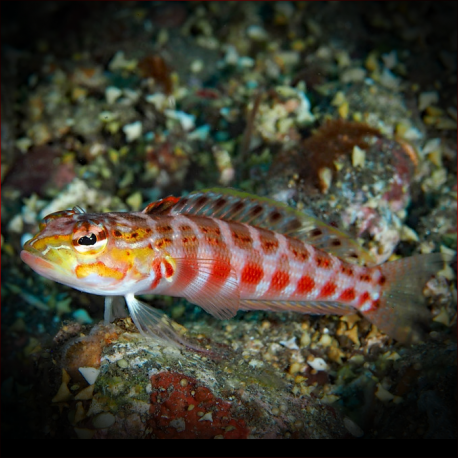More info
Datasheet
| Minimum Tank Size | 100 litres / 26.42 US gallons |
| Maximum Size | 18.0cm / 7.09inches |
| Reef Compatible | Reef safe with caution |
| Temperament | Aggressive towards other species |
| Temperature | 22.2°C / 71.96°F - 25.6°C / 78.08°F |
| Specific Gravity | 1.020-1.025 |
| Carbonate Hardness | 8-12 |
| pH | 8.1-8.4 |
General Description
The Redspotted Sandperch, scientifically known as Parapercis schauinslandii, belongs to the Pinguipedidae family. These fish are native to the Indo-Pacific region, spanning from East Africa to Pitcairn, with their habitat extending north to Japan and south to the Great Barrier Reef. They are recognized by various common names including Sand perch, Lyre-tail grubfish, Flagfin weaver, and Redspotted sandperch.
Aquarium Suitability
With a temperament described as aggressive towards other species, Redspotted Sandperches are considered suitable for aquariums with caution. They are known to be aggressive towards bottom-dwelling animals and pose a threat to smaller fish. Additionally, they can be a danger to crustaceans such as shrimps and crabs. These fish exhibit jumping behavior, requiring aquariums with secure lids to prevent escape.
Demands, Care, and Hardiness
Redspotted Sandperches are classified as hardy fish species. They thrive on frequent feedings, especially when newly introduced to an aquarium. These fish have hermaphroditic capabilities, with females being able to change into males when needed. They are often found living in pairs, typically comprising a male and a female. To mimic their natural habitat, it is recommended to provide a sandy substrate covering about 30% of the tank bottom.
Reef Suitability
Categorized as reef-safe with caution, Redspotted Sandperches should be introduced carefully into reef aquariums due to their aggressive nature towards smaller tank mates and crustaceans. Their compatibility with fragile reef ecosystems may vary, necessitating close monitoring.
Aquarium Setup
To create a suitable environment for Redspotted Sandperches, aquarists should provide a tank with at least 100 liters of water capacity. A significant portion of the tank bottom should be covered with sand or gravel, mimicking their natural habitat. When setting up smaller tanks, it is advised to increase the sand-covered area to a minimum of 50%. Maintaining stable water conditions with a temperature range of 22.2-25.6°C, pH between 8.1-8.4, a specific gravity of 1.020-1.025, and a carbonate hardness of 8-12 dKH is crucial.
Behaviour
Known for their aggressive temperament, Redspotted Sandperches may display territorial behavior and are prone to aggression towards bottom-dwelling tank mates. These fish are active hunters, preying on small fish and larger crustaceans in the wild. In an aquarium setting, they exhibit a preference for live food and have a reputation for being voracious eaters.
Feeding and Diet
Redspotted Sandperches have a diverse diet that includes fish, larger crustaceans like shrimp and crabs, and small crustaceans such as krill, mysis, and artemia. To ensure their nutritional needs are met, these fish should be fed multiple times a day, with a focus on providing a varied diet that mimics their natural feeding habits.
Dimorphism and Captive Reproduction
In captivity, Redspotted Sandperches can change gender from female to male when necessary. For those interested in breeding these fish, acquiring a pair at a young age or obtaining two females is recommended to facilitate successful reproduction. The breeding behavior of these fish can provide insights into their social dynamics within an aquarium setting.
Habitat and Distribution
Redspotted Sandperches predominantly inhabit sandy areas in the Indo-Pacific region, ranging from East Africa to Pitcairn. While not found in the Arabian Peninsula or the southern coast of Asia, these fish are prevalent throughout Oceania. Their distribution highlights their preference for tropical waters with sandy substrates, where they can actively hunt for prey and exhibit their territorial behavior.

